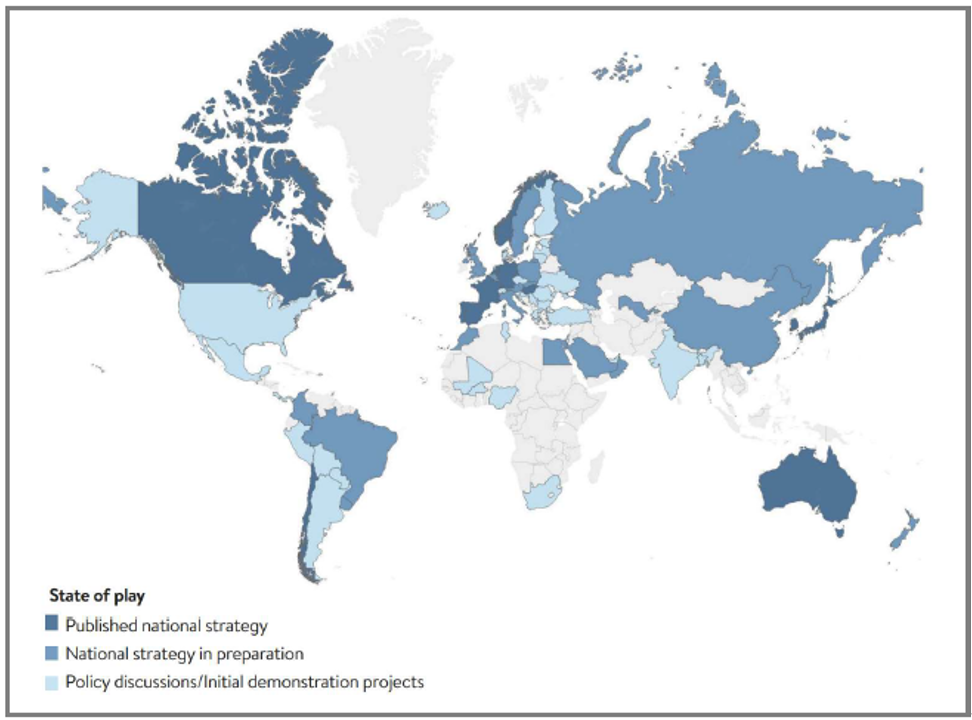Hydrogen strategies

For the success of the energy transition, hydrogen (H2) is assigned a central role on a global, national and regional level. In this context, numerous countries have already published their own development strategies for the energy carrier, which provide a political framework for the future production, storage and use of H2 in order to increase not only its economic viability but also its usability in all sectors. [01]
Back in 2017, Japan became the first country in the world to publish a unified national strategy for H2 to support the development of a domestic market for technologies related to this energy carrier. This will initially focus on research into fuel cells and the application of gray H2 in the automotive industry until the market potential of climate neutral H2 has increased worldwide. [02, p. 431] In contrast, the European H2 strategy announced as part of the 2020 Green Deal focuses on the development of GW-scale electrolysers to accelerate the production of renewable H2. With the European Union's (EU) stated goal of installing around 46 GW of electrolysis capacity between 2020 and 2030, larger and more efficient electrolysers are imperative. In addition to H2 production, Horizon Europe is also funding numerous research and innovation projects for the distribution, storage and end-user application of H2, including the further development of fuel cell technologies. The long-term goal is to support the EU's climate neutrality and economic recovery from the effects of the Covid-19 pandemic, as well as to strengthen global leadership in H2 technologies. [03]
To ensure a complete H2 supply chain in the future, further initiatives are important to set a development path for technologies along the entire value chain. As the map below illustrates in this regard, efforts are already underway on nearly every continent to design national H2 strategies to build a sustainable energy system. [04]
Although only a total of 12 countries and the EU have announced their national H2 strategies by 06.07.2021, the 19 other strategies currently in progress show that the development of a global H2 economy has long since begun. While many these strategies originate from countries on the European continent, the major economic powers China and the USA, for example, whose developments in the energy sector are crucial for the global future of the energy industry, have not yet published their own H2 strategies. However, many demonstration projects are currently testing the use of various H2 applications in the Chinese and U.S. markets. In summary, the map shown above illustrates that more H2 strategies will follow, especially in those countries and regions where a transformation of energy systems is expected in the coming years. [04]
Previous publications show that Australia and Saudi Arabia, among others, want to become leading export nations for green H2 due to their potential for solar energy, whereas Germany will have to import large quantities of H2 in the future. For this, the national H2 strategy of the Federal Republic of Germany, announced in 2020, specifies investments and innovations for the generation, storage and further use of H2 in order to be able to achieve market leadership in H2 technologies in the long term. In the coming years, energy partnerships and H2 alliances are to help establish the energy carrier in the industrial, transport and heating sectors on a permanent basis. [04, 05] In addition, individual German states have also developed H2 strategies to better integrate regional structures and state-specific opportunities into the European and national framework. In this context, the Free State of Saxony focuses on the further development of power-to-X applications, electrolysis and fuel cell systems, as well as the establishment of a complete H2 infrastructure, so that, in addition to a significant contribution to sector coupling, the diverse application of the energy carrier within the Free State is also made possible in the medium term [06].
Although each of these strategies includes site-specific priorities, the general aim is to support the decarbonization of energy systems and integration of renewables. In addition, H2 can contribute to energy supply diversification, promote technology development, and increase economic growth. In this context, the global demand for green H2 is already expected to increase sharply in the coming years. [04]
References:
- FEDERAL MINISTRY OF ECONOMICS AND CLIMATE PROTECTION (ed.) (2022): Hydrogen: Key element for the energy transition, 2022.
- https://www.bmwk.de/Redaktion/DE/Dossier/wasserstoff.html last accessed 04/29/2022, 15:54.
- SCHMIDT, T. (2020): Hydrogen technology - fundamentals, systems, application, economics, Hanser Verlag, Munich, 2020.
- EUROPEAN COMMISSION (ed.) (2020): A hydrogen strategy for a climate-neutral Europe, 2020.
- WORLD ENERGY COUNCIL (ed.) (2021): Working Paper - National Hydrogen Strategies, 2021.
- FEDERAL MINISTRY OF ECONOMICS AND ENERGY (ed.) (2020): The National Hydrogen Strategy, 2020.
- SAXON STATE MINISTRY FOR ENERGY, CLIMATE PROTECTION, ENVIRONMENT AND AGRICULTURE (ed.) (2021): Saxon Hydrogen Strategy, 2021.